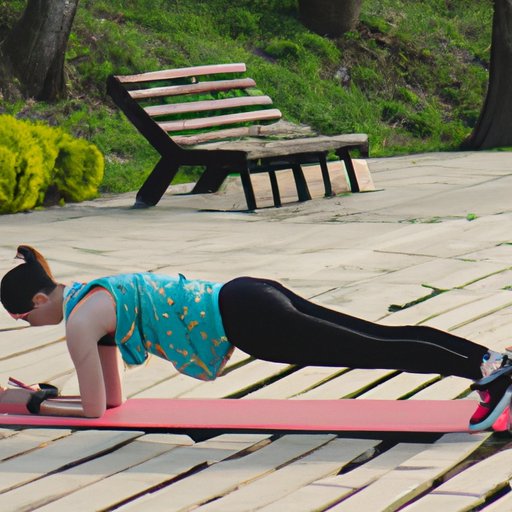Introduction
Bridge exercises are an effective way to strengthen the core and increase stability. They are often used as part of a warm up, or as a way to add variety to a workout. This article will explore the definition of bridge exercises, the benefits they provide, and a beginner’s guide to incorporating them into your workout routine.
Definition of Bridge Exercises
A bridge exercise is an exercise that strengthens the core by engaging the glutes, hamstrings, and lower back. The exercise involves lying on your back with your feet flat on the floor and your arms at your sides. From this position, you raise your hips off the ground until your body forms a straight line from your shoulders to your knees. You then hold this position for several seconds before returning to the starting position.
Benefits of Bridge Exercises
Bridge exercises offer a number of benefits. They can help improve balance and posture, increase core strength and stability, and reduce the risk of injury. According to a study published in the Journal of Strength and Conditioning Research, bridge exercises can also help improve hip mobility and reduce low-back pain.
A Beginner’s Guide to Bridge Exercises
Bridge exercises are a great way to add variety to your workout routine. Here are some tips for incorporating bridge exercises into your workouts:
How to Incorporate Bridge Exercises into Your Workout
Start by doing one set of 8-10 repetitions. Make sure to keep your core engaged throughout the exercise. As you become more comfortable with the movement, you can increase the number of sets and reps. You can also add variations to the exercise, such as adding a pulse at the top of the movement or doing single-leg bridges.
The Benefits of Bridge Exercises for Strength and Stability
Bridge exercises are great for strengthening the core and improving overall stability. According to a study published in the Journal of Physical Therapy Science, bridge exercises can help improve balance and coordination, as well as reduce the risk of falls in older adults.
Adding Variety to Your Workouts with Bridge Exercises
Bridge exercises can be done as part of any workout routine. You can use them as a warm-up before a run or a strength workout, or as part of a HIIT circuit. You can also combine them with other exercises, such as squats and lunges, to create a full-body workout.
What Muscles Do Bridge Exercises Target?
Bridge exercises target multiple muscle groups, including the primary and secondary muscles. Here’s a look at which muscles are used during bridge exercises:
Primary Muscle Groups Used During Bridge Exercises
The primary muscle groups used during bridge exercises are the glutes, hamstrings, and lower back. These muscles are responsible for supporting the spine and providing stability during the exercise.
Secondary Muscle Groups Used During Bridge Exercises
The secondary muscle groups used during bridge exercises include the abs, quads, and hip flexors. These muscles work together with the primary muscle groups to support the spine and stabilize the body during the exercise.
Common Mistakes to Avoid When Doing Bridge Exercises
Although bridge exercises are relatively simple, it’s important to pay attention to form and technique. Here are some common mistakes to avoid when doing bridge exercises:
Not Engaging the Core Muscles
One of the most important aspects of bridge exercises is engaging the core muscles. Without engaging the core muscles, you won’t be able to maintain proper form and you won’t get the full benefit of the exercise.
Not Maintaining Proper Form
It’s important to maintain proper form when doing bridge exercises. Make sure your spine is in a neutral position and your hips are raised evenly. If you find yourself arching your back or shifting your weight, take a break and reset your form.
Not Progressing at the Right Pace
As with any exercise, it’s important to progress at the right pace. Start with basic bridge exercises and gradually add more reps and sets as you become stronger. Don’t increase the intensity too quickly or you may risk injury.
Conclusion
Bridge exercises are a great way to improve your strength and stability. They can help improve balance and posture, increase core strength and stability, and reduce the risk of injury. To get the most out of bridge exercises, make sure to engage the core muscles, maintain proper form, and progress at the right pace. With practice and dedication, you can reap the many benefits of bridge exercises.
Summary of Benefits of Bridge Exercises
Bridge exercises offer a number of benefits, including improved balance and posture, increased core strength and stability, and reduced risk of injury. They can also help improve hip mobility and reduce low-back pain.
Final Thoughts on Bridge Exercises
Bridge exercises are a great way to add variety to your workout routine. With practice and dedication, you can reap the many benefits of bridge exercises. Remember to engage the core muscles, maintain proper form, and progress at the right pace to get the most out of your workouts.
(Note: Is this article not meeting your expectations? Do you have knowledge or insights to share? Unlock new opportunities and expand your reach by joining our authors team. Click Registration to join us and share your expertise with our readers.)
